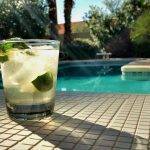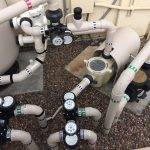The circulation system of a pool plays a major role in cleaning, sanitizing and heating the water. Above ground or inground, temporary or permanent, simple or fancy, all pools have a circulation system and they are all remarkably similar. Water is pulled from the pool via one or more skimmers and sometimes one or more main drains by an electric pump. The pump provides pressure to push the water through a filter, and other water treatment or heating devices, then back into the pool via one or more returns.
Skimmers
Skimmers are boxes in the sides of the pool at the waterline. The water at the surface along with debris floating on the water surface is pulled into the skimmer. A floating door, called a weir, controls the size of the skimmer opening to maximize the speed of the water and debris as it enters the skimmer, and to prevent debris in the skimmer from returning to the pool when the pump is off. The skimmer has a large basket at the bottom to trap debris like leaves and insects so that the may be removed before the water enters the pool plumbing.
Main Drains
Main drains are located in the bottom of the pool, and contrary to the name are used as a source of water for the pump, not to drain the pool. The location of the drain at the bottom improves the circulation of water in the pool. Most inground pools have at least one main drain, and some above ground pools have a main drain as well.
Returns
Returns are the outlets placed slightly below the water’s surface in the pool. Filtered, treated and heated water returns to the pool via the returns. Returns usually have an adjustable ‘eyeball’ that allows the water flow to be aimed to help improve flow of debris to the skimmers and general circulation of the water within the pool.
Pumps
The pump is the heart of the circulatory system, which is an apt analogy. The pump drives virtually everything that happens to the pool water, and a pump failure usually results in a green pool fairly quickly.
Inground and above ground pumps are slightly different in construction due to the fact that inground pumps are normally located above the water level, while above ground pumps are located below the water level where gravity forces water into them. Inground pumps are self-priming, which means they can fill the intake line with water themselves by pumping air out of the line. Water is drawn into the pump by the vacuum created on the inlet side of the pump, until the water fills the pump and the pump begins to pump water. Air leaks on the intake side prevent this vacuum from forming, preventing the pump from priming. Once the pump is primed, air leaks on the inlet side can cause bubbles in the water flow, and if significant enough they can prevent the pump from moving water at all. When the pump has been pumping water, but flow stops due to air leaks, it is known as losing prime.
As water reaches the pump from the skimmers and main drains, the water enters the strainer basket housing, a section of the pump with a removable air-tight lid which contains a basket to trap large debris to protect the pump. Regular cleaning of this basket is usually necessary to maintain good water flow.
After flowing through the strainer basket, water enters the impeller, a rotating device which pushes the water out of the pump. The pushing action of the pump pressurizes the water on the outlet or pressure side of the system. Since the water is under pressure, leaks on this side of the pump show up as dripping or spraying water above ground, or soggy spots if the leak is located below ground.
Filter
After leaving the pump, the water enters the filter. There is a valve on the inlet of the filter that allows the user to determine where the water goes next, and where the water leaving the filter goes. Different filters have different valve types, and the functions of the different settings are filter-specific.
There are various types of filters used in pools, but all operate on the same general principle. The filter material has very small openings, which stop the dirt from flowing through with the water. The openings are so small that the water can’t even move through easily. As a result, the pressure of the water between the pump and the filter outlet is raised, much like the pressure in a garden hose increases when you restrict the water flow by placing your thumb over the end. As these paths become clogged with debris, it becomes harder for water to pass through the filter, resulting in higher than normal filter pressure. Increase in filter pressure indicates the need for a filter cleaning, which involves flushing the debris or creating a new layer of filter material.
After leaving the filter, the clean water may also pass through tablet chlorinators, liquid chlorinators, salt water chlorine generators, ozonators, UV sanitizers or heaters before returning to the pool.
In addition to the things done to the water while it is in the circulation system, circulation also affects the water within the pool. The mixing and distribution of water performed by the circulation system ensures that any contaminants in the water are constantly being exposed to fresh sanitizer, and that the water temperature remains fairly constant throughout the pool.
The circulation system is critically involved in virtually every function that is required to keep your pool water clear, sanitary and comfortable. A good circulation system is as important as good water chemistry in maintaining a healthy and beautiful pool.





